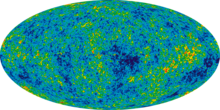| Part of a series on |
| Physical cosmology |
|---|
 |
In physical cosmology, the hadron era[1]: 209 started 10-44 seconds (or 10-8 seconds[2] and end at 10-4. Initially, the temperature was high enough to allow the formation of hadron/anti-hadron pairs, which kept matter and anti-matter in thermal equilibrium. Most of the hadrons and anti-hadrons were eliminated in annihilation reactions, leaving a small residue of hadrons. Upon elimination of anti-hadrons, the Universe was dominated by photons, neutrinos and electron-positron pairs. This period is referred to as the lepton era.[2]
Constituents
Combining particle physics models with the standard Lambda-CDM model of cosmological expansion, suggests when expansion cooled the universe to a transition temperature around 150MeV hadron formation was favored. From this time until neutrino decoupling, antimatter is an important constiutent of the universe.[3]
See also
References
- ^ Kleczek, Josip (1976). The Universe. Episteme Ser. Dordrecht: Springer Netherlands. ISBN 978-94-010-1485-4.
- ^ a b Karttunen, Hannu; Kröger, Pekka; Oja, Heikki; Poutanen, Markku; Donner, Karl Johan, eds. (2003). Fundamental astronomy. Physics and astronomy (4 ed.). Berlin Heidelberg: Springer. ISBN 978-3-540-00179-9.
- ^ Rafelski, J.; Birrell, J.; Steinmetz, A.; Yang, C. T. (June 27, 2023). "A short survey of matter-antimatter evolution in the Primordial Universe". Universe. 9 (7): 309. arXiv:2305.09055. Bibcode:2023Univ....9..309R. doi:10.3390/universe9070309.









You must be logged in to post a comment.